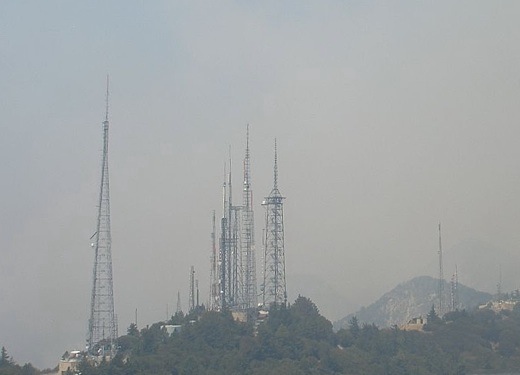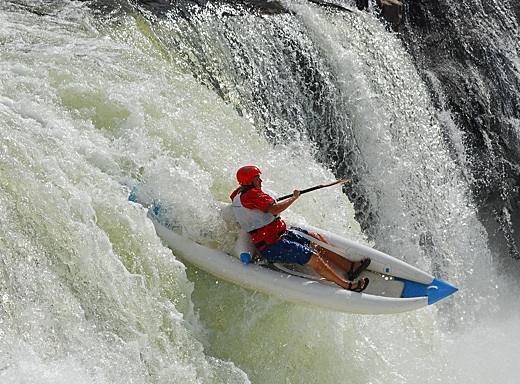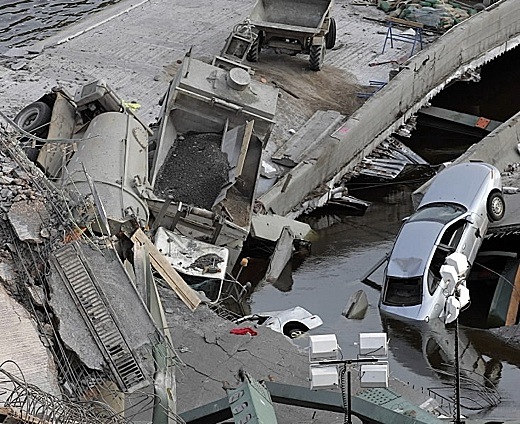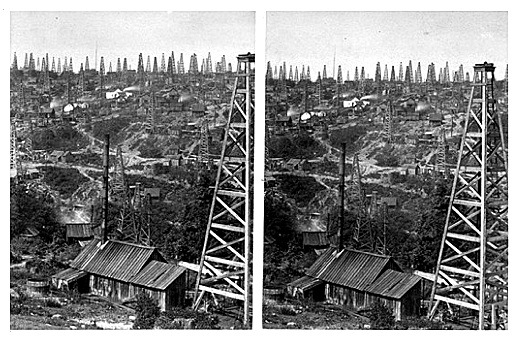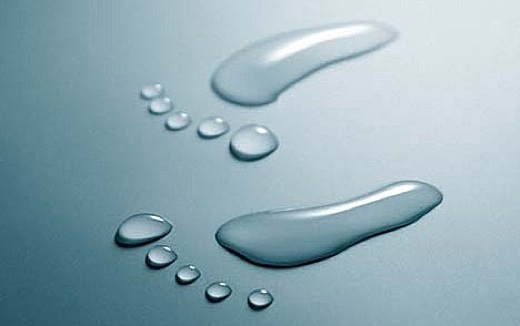SUBHEAD: It's not about hope or despair. It's about facing reality and dealing with it.
By Adam D. Sacks on 23 August 2009 in Grist -
(http://www.grist.org/article/2009-08-23-the-fallacy-of-climate-activism)
 Image above: Ranchers, soybean farmers and loggers burned down and clear cut
a near-record area of the Amazon rainforest last year.
From: http://www.guardian.co.uk/environment/2008/dec/07/meat-soya-environment-paraguay
Image above: Ranchers, soybean farmers and loggers burned down and clear cut
a near-record area of the Amazon rainforest last year.
From: http://www.guardian.co.uk/environment/2008/dec/07/meat-soya-environment-paraguay
In the 20 years since we climate activists began our work in earnest, the state of the climate has become dramatically worse, and the change is accelerating — this despite all of our best efforts. Clearly something is deeply wrong with this picture. What is it that we do not yet know? What do we have to think and do differently to arrive at urgently different outcomes?
[1]The answers lie not with science, but with culture.
Climate activists are obsessed with greenhouse-gas emissions and concentrations. Since global climate disruption is an effect of greenhouse gases, and a disastrous one, this is understandable. But it is also a mistake. Such is the fallacy of climate activism
[2]: We insist that global warming is merely a consequence of greenhouse-gas emissions. Since it is not, we fail to tell the truth to the public.
I think that there are two serious errors in our perspectives on greenhouse gases.
Global Warming as SymptomThe first error is our failure to understand that greenhouse gases are not a cause but a symptom, and addressing the symptom will do little but leave us with a devil’s sack full of many other symptoms, possibly somewhat less rapidly lethal but lethal nonetheless.
The root cause, the source of the symptoms, is 300 years of our relentlessly exploitative, extractive, and exponentially growing technoculture, against the background of ten millennia of hierarchical and colonial civilizations.
[3] This should be no news flash, but the seductive promise of endless growth has grasped all of us civilized folk by the collective throat, led us to expand our population in numbers beyond all reason and to commit genocide of indigenous cultures and destruction of other life on Earth.
To be sure, global climate disruption is the No. 1 symptom. But if planetary warming were to vanish tomorrow, we would still be left with ample catastrophic potential to extinguish many life forms in fairly short order: deforestation; desertification; poisoning of soil, water, air; habitat destruction; overfishing and general decimation of oceans; nuclear waste, depleted uranium, and nuclear weaponry—to name just a few. (While these symptoms exist independently, many are intensified by global warming.)
We will not change course by addressing each of these as separate issues; we have to address root cultural cause.
Beyond Greenhouse Gas EmissionsThe second error is our stubborn unwillingness to understand that the battle against greenhouse-gas emissions, as we have currently framed it, is over.
It is absolutely over and we have lost.
We have to say so.
There are three primary components of escalating greenhouse-gas concentrations that are out of our control.
Thirty-Year Lag
The first is that generally speaking the effects we are seeing today, as dire as they are, are the result of atmospheric concentrations of carbon dioxide in the range of only 330 parts per million (ppm), not the result of today’s concentrations of almost 390 ppm. This is primarily a consequence of the vast inertial mass of the oceans, which absorb temperature and carbon dioxide and create a roughly 30-year lag between greenhouse-gas emissions and their effects. We are currently seeing the effects of greenhouse gases emitted before 1980.
Just as the scientific community hadn’t realized how rapidly and extensively geophysical and biological systems would respond to increases in atmospheric greenhouse-gas concentrations, we currently have only a rough idea of what that 60 ppm already emitted will mean, even if we stopped our emissions today. But we do know, with virtual certainty, that it will be full of unpleasant surprises.
Positive Feedback Loops
The second out-of-control component is positive (amplifying) feedback loops. The odd thing about positive feedbacks is that they are often ignored in assessing the effects of greenhouse-gas emissions. Our understanding of them is limited and our ability to insert them into an equation is rudimentary. Our inability to grasp them, however, in no way mitigates their effects, which are as real as worldwide violent weather.
It is now clear that several phenomena are self-sustaining, amplifying cycles; for example, melting ice and glaciers, melting tundra and other methane sources, and increasing ocean saturation with carbon dioxide, which leads to increases in atmospheric carbon dioxide. These feedbacks will continue even if we reduce our human emissions to zero—and all of our squiggly lightbulbs, Priuses, wind turbines, Waxman-Markeys, and Copenhagens won’t make one bit of difference. Not that we shouldn’t stop all greenhouse-gas emissions immediately—of course we should—but that’s only a necessity, not nearly a sufficient response.
We need to find the courage to say so.
Non-Linearity
The third component is non-linearity, which means that the effects of rising temperature and atmospheric carbon concentrations may change suddenly and unpredictably. While we may assume linearity for natural phenomena because linearity is much easier to assess and to predict, many changes in nature are non-linear, often abruptly so. A common example is the behavior of water. The changes of state of water—solid, liquid, gas—happen abruptly. It freezes suddenly at 0°C, not at 1°, and it turns to steam at 100°, not at 99°. If we were to limit our experience of water to the range of 1° to 99°, we would never know of the existence of ice or steam.
This is where we stand in relationship to many aspects of the global climate. We don’t know where the tipping points—effectively the changes of state—are for such events as the irreversible melting of glaciers, release of trapped methane from tundras and seabeds, carbon saturation of the oceans. Difficult to pin down, tipping points may be long past, or just around the corner. As leading climatologist Jim Hansen has written, “Present knowledge does not permit accurate specification of the dangerous level of human-made GHGs. However, it is much lower than has commonly been assumed. If we have not already passed the dangerous level, the energy infrastructure in place ensures that we will pass it within several decades.”[4]
Evidence of non-linearity is strong, not only from the stunning acceleration of climate change in just the past couple of years, but from the wild behavior of the climate over millions of years, which sometimes changed dramatically within periods as short as a decade.
The most expert scientific investigators have been blindsided by the velocity and extent of recent developments, and the climate models have likewise proved far more conservative than nature itself. Given that scientists have underestimated impacts of even small changes in global temperature, it is understandably difficult to elicit an appropriate public and governmental response.
Beyond the BoxWe climate activists have to tread on uncertain ground and rapidly move beyond our current unpleasant but comfortable parts-per-million box. Here are some things we need to say, over and over again, everywhere, in a thousand different ways: Bitter climate truths are fundamentally bitter cultural truths. Endless growth is an impossibility in the physical world, always—but always—ending in overshot and collapse. Collapse: with a bang or a whimper, most likely both. We are already witnessing it, whether we choose to acknowledge it or not.
Because of this civilization’s obsession with growth, its demise is 100 percent predictable. We simply cannot go on living this way. Our version of life on earth has come to an end.
Moreover, there are no “free market” or “economic” solutions. And since corporations must have physically impossible endless growth in order to survive, corporate social responsibility is a myth. The only socially responsible act that corporations can take is to dissolve.
We can’t bargain with the forces of nature, trading slightly less harmful trinkets for a fantasied reprieve. Geophysical processes care not one whit for our politics, our economics, our evening meals, our theologies, our love for our children, our plaintive cries of innocence and error.
We can either try to plan the transition, even at this late hour, or the physical forces of the world will do it for us—indeed, they already are. As Alfred Crosby stated in his remarkable book, Ecological Imperialism, mother nature’s ministrations are never gentle.
[5]Telling the TruthIf we climate activists don’t tell the truth as well as we know it—which we have been loathe to do because we ourselves are frightened to speak the words—the public will not respond, notwithstanding all our protestations of urgency.
And contrary to current mainstream climate-activist opinion, contrary to all the pointless “focus groups,” contrary to the endless speculation on “correct framing,” the only way to tell the truth is to tell it. All of it, no matter how terrifying it may be.
[6]It is offensive and condescending for activists to assume that people can’t handle the truth without environmentalists finding a way to make it more palatable. The public is concerned, we vaguely know that something is desperately wrong, and we want to know more so we can try to figure out what to do. The response to An Inconvenient Truth, as tame as that film was in retrospect, should have made it clear that we want to know the truth.
And finally, denial requires a great deal of energy, is emotionally exhausting, fraught with conflict and confusion. Pretending we can save our current way of life derails us and sends us in directions that lead us astray. The sooner we embrace the truth, the sooner we can begin the real work.
Let’s just tell it.
Stating the ProblemAfter we tell the truth, then what can we do? Is it hopeless? Perhaps. But before we can have the slightest chance of meaningful action, having told the truth, we have to face the climate reality, fully and unflinchingly. If we base our planning on false premises—such as the oft-stated stutter that reducing our greenhouse-gas emissions will forestall “the worst effects of global warming”—we can only come up with false solutions. “Solutions” that will make us feel better as we tumble toward the end, but will make no ultimate difference whatsoever.
Furthermore, we can and must pose the problem without necessarily providing the “solutions.”
[7] I can’t tell you how many climate activists have scolded me, “You can’t state a problem like that without providing some solutions.” If we accept that premise, all of scientific inquiry as well as many other kinds of problem-solving would come to a screeching halt. The whole point of stating a problem is to clarify questions, confusions, and unknowns, so that the problem statement can be mulled, chewed, and clarified to lead to some meaningful answers, even though the answers may seem to be out of reach. Some of our most important thinking happens while developing the problem statement, and the better the problem statement the richer our responses. That’s why framing the global warming problem as greenhouse-gas concentrations has proved to be such a dead end.
Here is the problem statement as it is beginning to unfold for me. We are all a part of struggling to develop this thinking together:
We must leave behind 10,000 years of civilization; this may be the hardest collective task we’ve ever faced. It has given us the intoxicating power to create planetary changes in 200 years that under natural cycles require hundreds of thousands or millions of years—but none of the wisdom necessary to keep this Pandora’s Box tightly shut. We have to discover and re-discover other ways of living on earth.
We love our cars, our electricity, our iPods, our theme parks, our bananas, our Nikes, and our nukes, but we behave as if we understand nothing of the land and water and air that gives us life. It is past time to think and act differently.
If we live at all, we will have to figure out how to live locally and sustainably. Living locally means we are able get everything we need within walking (or animal riding) distance. We may eventually figure out sustainable ways of moving beyond those small circles to bring things home, but our track record isn’t good and we’d better think it through very carefully.
Likewise, any technology has to be locally based, using local resources and accessible tools, renewable and non-toxic. We have much re-thinking to do, and re-learning from our hunter-gatherer forebears who managed to survive for a couple of hundred thousand years in ways that we with our civilized blinders we can barely imagine or understand.
[8]Living sustainably means, in Derrick Jensen’s elegantly simple definition, that whatever we do, we can do it indefinitely.
[9] We cannot use up anything more or faster than nature provides, we don’t poison the air, water, or soil, and we respect the web of life of which we are an intricate part. We are not separate from nature, or above it, or in any way qualified to supervise it.
[10] The evidence is ample and overwhelming; all we have to do is be brave enough to look.
How do we survive in a world that will probably turn—is already turning, for many humans and non-humans alike—into a living hell? How do we even grow or gather food or find clean water or stay warm or cool while assaulted by biblical floods, storms, rising seas, droughts, hurricanes, tornadoes, snow, and hail?
It is crystal clear that we cannot leave it to the technophiliacs. It is human technology coupled with our inability to comprehend, predict, and prevent unintended consequences that have brought us global catastrophe, culminating in climate disruption, in the first place. Desperate hopes notwithstanding, there are no high-tech solutions here, only wishful thinking—the tools that got us into this mess are incapable of getting us out.
[11]All that being said, we needn’t discard all that we’ve learned, far from it.
[12] But we must use our knowledge with great discretion, and lock much of it away as so much nuclear weaponry and waste.
Time is running very short, but the forgiveness of this little blue orb in a vast lonely universe will continue to astonish and nourish us—if we only give it the chance.
Our obligation as activists, the first step, the essence, is to part the cultural veil at long last, and to tell the truth.
Endnotes:[1] Many thanks to Richard Grossman, who posed that question fifteen years ago with respect to corporate domination of governance and culture when he founded the Program on Corporations, Law and Democracy (
POCLAD). He understood that we must take the time to stop and penetrate beyond the obvious if we are to think outside of the cultural prescriptions that constrain our ability to act differently. Many thanks as well to
Ross Gelbspan, a courageous and ground-breaking journalist, who early on investigated the forces driving the fossil fuel machine and has been sounding the alarm for almost two decades. See his excellent article, “
Beyond the Point of No Return,” December 2007, which inspired many of the ideas in this piece.
[2] I would like to express deep gratitude to John A. Livingston, pioneer environmentalist, preservationist, teacher and writer. In 1981 he wrote “The Fallacy of Wildlife Conservation,” which inspired the title of this piece. The fallacy that Livingston was referring to is well-described in the foreword by Graeme Gibson: “The Fallacy of Wildlife Conservation, as a statement of belief, is one of the fiercest and most uncompromising of John Livingston’s convictions. Had he entitled it ‘The Failure of Wildlife Conservation,’ we might have tried again—without having to think too much about it. But he didn’t. ... As a result of the word fallacy, we are confronted with an insistence that we rethink everything.” From The John A. Livingston Reader, McClelland & Stewart, 2007, pp. xiv-xv. So it is, with the fallacy of climate activism, that we must rethink everything.
[3] Endless (exponential) growth is an impossibility in a finite physical system (planet earth), and we have a wealth of examples of overshoot and collapse, non-human and human, all of which are fully predictable. Our cultural inability to grasp such an obvious reality is a primary obstacle to progress in addressing climate change and its root cause. Indigenous cultures tend to have much better understandings of these things. See Herman E. Daly and Kenneth N. Townsend, “Sustainable Growth: An Impossibility Theorem,” from
Valuing The Earth: Economics, Ecology, Ethics, MIT Press, 1993, p. 267 ff. For a wide-ranging discussion of the demise of civilizations, see Jared Diamond, Collapse, Viking, 2005.
[4] James Hansen et al.(2007), “
Climate change and trace gases,” Phil. Trans. Roy. Soc. A 365: 1925–1954 (2007).
[5] Alfred W. Crosby, Ecological Imperialism: The Biological Expansion of Europe, 900 - 1900, Cambridge University Press, 1986, p. 92. The actual quote, referring to population, is, “Mother nature always comes to the rescue of a society stricken with the problems of overpopulation, and her ministrations are never gentle.”
[6] A word here about the skeptics, with whom we are also obsessed: Forget about them. They may appear to have control of the public discussion, but they are babbling into the abyss. Our enemy is us. By our own unwillingness to face the profound implications of climate change—that we have to reject civilization as currently conceived and come up with something completely different—we are doing far more damage to the cause of preserving life on earth than the deniers could ever do.
[7] “One of the more peculiar traits of our society is its assumption—its insistence—on solutions. Just as there are reasons for all things, so there are solutions for all things. Always there are ultimate answers; there is no problem that is not amenable to logical reduction. This, as we have seen earlier, in spite of such bewildering enterprises as ecology. I have no ‘solution’ to the wildlife preservation problem [read ‘global warming problem’]. There may not be one. But given the somewhat shaky assumption that one exists, I sense that I can at least feel the direction.” John A. Livingston, The Fallacy of Wildlife Conservation, p. 151.
[8] Our culturally skewed and defensive view of pre-hierarchical societies, seeing only lives that were “nasty, brutish and short” struggling to survive in “nature, red in tooth and claw,” has distorted earlier human experience beyond recognition. See, for example, Riane Eisler, The Chalice and the Blade, Harper & Rowe, 1987; and Marshall Sahlins, Stone Age Economics, Tavistock Publications, Ltd. (London), 1974.
[9] Jensen is one of our most passionate and incisive cultural critics and environmental writers. His words are, “For an action to be sustainable, you must be able to perform it indefinitely. This means that the action must either help or at the very least not materially harm the landbase. If an action materially harms the landbase, it cannot be performed indefinitely ...” From Derrick Jensen and Aric McBay, What We Leave Behind, p. 56.
[10] Although, as I indicate in footnote 12 in a brief discussion of holistic management of grasslands, we can and must repair enough of the damage so that the infinitely complex self-organizing systems of nature—the systems that gave life to all living creatures—can begin anew.
[11] For example, consider hare-brained schemes from very smart scientists, some of whom know that the schemes are hare-brained but in their desperation see no other way. A recent article in Rolling Stone, “
Can Dr. Evil Save The World?,” has an interesting overview of the geo-engineering debate. The bottom line seems to be that we currently are able to do and think anything except changing the way we live, and risking the existence of life on earth is simply a chance we have to take (although 100 percent odds of failure is hardly a bet one should want to take, assuming there are any rational moments left). See also Ross Gelbspan’s article, “Beyond the Point of No Return,” footnote 1.
[12] Glimmers of hope lie in the remarkable restorative powers of the earth. One such phenomenon is ancient pre-history but new to us. That is the relationship between grazers and grasslands. Whereas conventional grasslands management destroys soils and diversity, nature’s way sequesters vast amounts of carbon in soils, with photosynthesizing plants as intermediators along with fungi, micro-organisms, insects, animals and birds—and creates productive and healthy land that, unlike forests, can bind carbon for thousands of years. We have the potential to remove gigatons of carbon from the atmosphere, reducing greenhouse gas concentrations by many parts per million with proper land management. Beyond grasslands, the planet’s power of regeneration, despite our assaults, remains extraordinary. See the
Holistic Management International website.
Another example is the
dramatic restoration of denuded rainforest in Borneo after only six years: “Planting finishes this year [2008], but already [Willie] Smits [the Indonesian forestry expert who led the replanting] and his team from the Borneo Orangutan Survival Foundation charity claim the forest is ‘mature’, with trees up to 35 metres high. Cloud cover has increased by 12 per cent, rainfall by a quarter, and temperatures have dropped 3-5°C, helping people and wildlife to thrive, says Smits. Nine species of primate have also returned, including the threatened orangutans. ‘If you walk there now, 116 bird species have found a place to live, there are more than 30 types of mammal, insects are there. The whole system is coming to life. I knew what I was trying to do, but the force of nature has totally surprised me. ... The place became the scene of an ecological miracle, a fairytale come true,’ says Smits, who has written a book about the project.”
.
.
